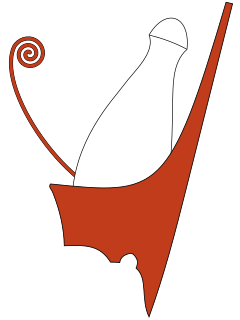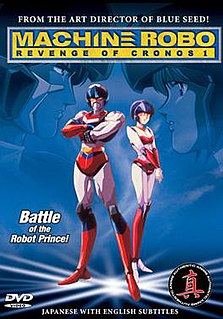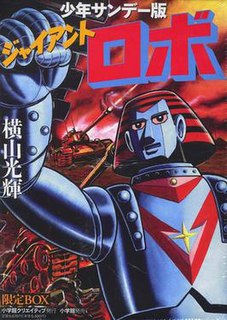| Nº | Title | Directed by: | Written by: | Air date |
|---|
| 1 | "Dracolon, The Great Sea Monster" | Manuel San Fernando | Reuben Guberman | 11 October 1967 (11 October 1967) |
|---|
| Shipwrecked, Daisaku Kusama (called Johnny Sokko in the American version) and Juro Minami (called Jerry Mano in the American version), an agent for Unicorn, drift to an island which proves to be a base of the BF Syndicate, an extra-terrestrial terrorist group from the Planet Gargoyle, who are bent on conquering the Earth in the name of their boss, an alien known as Emperor Guillotine. They happen to discover a huge robot created by for the BF Syndicate while they are escaping. Meanwhile, Emperor Guillotine commands the BF commander Spider to send Dakolar, a monster that destroy Daisaku and Juro's ship the other night, on a mission to attack Tokyo, the source of the Unicorn headquarters. Now under the control of Daisaku, will Giant Robo destroy Dakolar before Tokyo crumbles under the weight of the monster's enormous might? |
| 2 | "Nucleon, The Magic Globe" | Manuel San Fernando | Reuben Guberman | 18 October 1967 (18 October 1967) |
|---|
| Emperor Guillotine, the leader of the BF Syndicate, plans to take back Giant Robo, and in order to do so, he sent Spider and his men to capture Daisaku, the only one that can give orders to the robot. The Emperor also sends a huge metal globe called Globar to Earth. |
| 3 | "The Gargoyle Vine-A Space Plant" | Manuel San Fernando | Reuben Guberman | 25 October 1967 (25 October 1967) |
|---|
| Under Emperor Guillotine's orders after being brought from the far planet, Dr. Over (called Dr. Botanus in the American version), another leading member of the BF Syndicate, comes to Earth with the seed of a devilish alien plant called the Satan Rose (called the Gargoyle Vine). |
| 4 | "Monster Ligon-Tyrox, A Strange Monster" | Manuel San Fernando | Reuben Guberman | 25 October 1967 (25 October 1967) |
|---|
| Emperor Guillotine sends his BF Syndicate minions (including Commander Spider and Doctor Over) and Ligon-Tyrox, a new weapon in the shape of a pyramid, to Earth. By operating Ligon-Tyrox, Dr. Over destroys oil fields in Arabia, one after another. |
| 5 | "The Gigantic Claw" | Manuel San Fernando | Reuben Guberman | 1 November 1967 (1 November 1967) |
|---|
| Dr. Tadokora develops QQV, a superstrong transparent metal. He tests it and QQV endures all the attacks of Giant Robo. The BF Syndicate watch the experiments using TV cameras and try to steal the specifications of QQV. |
| 6 | "Dragon, The Ninja Monster" | Manuel San Fernando | Reuben Guberman | 8 November 1967 (8 November 1967) |
|---|
| A monster called Dorogon swallows a jet plane of the Commonwealth of Sordia when it is flying and an atomic submarine of the Furenkov Republic when it is under the sea. This is the Emperor's plan to cause a world war. |
| 7 | "Our Enemy-Scalion" | Manuel San Fernando | Reuben Guberman | 15 November 1967 (15 November 1967) |
|---|
| The decoding office of the Japanese Branch of Unicorn Organization is in the basement of a lighthouse on the coast of the Pacific Ocean. |
| 8 | "The Challenge of the Two-Headed Monster" | Manuel San Fernando | Reuben Guberman | 22 November 1967 (22 November 1967) |
|---|
| Daisaku and Minami happen to help a one-eyed man whom BF members are chasing. According to the man's story, they are trying to kill him as a traitor because he became frightened by the inhumanity of the Syndicate and left it. |
| 9 | "Tentaclon-An Electric Monster" | Manuel San Fernando | Reuben Guberman | 29 November 1967 (29 November 1967) |
|---|
| Emperor Guillotine gives Dr. Over a spaceship equipped with all kinds of scientific weapons. After landing on Earth, Over sends an electric monster called Sparky to the grounds of a soccer game and kidnaps all 60,000 spectators as hostages. |
| 10 | "The Transformed Humans" | Manuel San Fernando | Reuben Guberman | 6 December 1967 (6 December 1967) |
|---|
| Dr. Over and Black Dia makes the resurrected Ligon-Tyrox swallow a train near Lake Biwa to kidnap Suzuki, one of the passengers and head of the Kyoto branch of Unicorn. |
| 11 | "The Terrifying Sand Creature" | Manuel San Fernando | Reuben Guberman | 13 December 1967 (13 December 1967) |
|---|
| The underground office of the South Pole Unicorn branch is buried in red sand which suddenly started to gush out in the ice field. As the communications are cut off, Azuma sends Daisaku and Ninami there to see what happened. |
| 12 | "Amberon The Synthetic Monster" | Manuel San Fernando | Reuben Guberman | 20 December 1967 (20 December 1967) |
|---|
| Unicorn members locate the secret headquarters of the Japanese branch of the BF Syndicate. They attack the house and arrest Dr. Over by taking his blue star-shaped medal on his chest, the source of his power. |
| 13 | "Opticorn Must Be Destroyed" | Manuel San Fernando | Reuben Guberman | 27 December 1967 (27 December 1967) |
|---|
| There is a small quiet Allah Republic at the foot of the Alps; the only product of this beautiful country is gold. Her peace is broken when a vein of new ore is found in a gold mine. |
| 14 | "The Monstrous Flying Jawbone" | Manuel San Fernando | Reuben Guberman | 3 January 1968 (3 January 1968) |
|---|
| The office of Unicorn's Chinese branch is attacked by tank corps led by Red Cobra. Chang, its head, asks the help of the Japanese Branch. Azuma, Daisaku and Minami fly there on Giant Robo's back. |
| 15 | "Igganog-The Ice-Berg Monster" | Manuel San Fernando | Reuben Guberman | 10 January 1968 (10 January 1968) |
|---|
| Daisaku and Minami suspect that a strange villa standing in the heart of the Japanese Alps is a secret base of the BF Syndicate. They approach the house to get some proof, when men in the house notice them and look for them. |
| 16 | "Torozon-An Enemy Robot" | Manuel San Fernando | Reuben Guberman | 17 January 1968 (17 January 1968) |
|---|
| Beginning with the Swiss branch, the Unicorn branch headquarters are mysteriously destroyed one after another — Rome, Cairo, Bombay, Singapore, Hong Kong, then Tapai. It is easy to guess that Tokyo will be next. |
| 17 | "Destroy the Dam" | Manuel San Fernando | Reuben Guberman,
Masaru Igami,
Hirô Matsuda,
Mon Shichijô | 24 January 1968 (24 January 1968) |
|---|
| The Satan Rose is back and this time it has sucked up all of the water in a lake, with Dr. Over and Red Cobra overseeing the monster's rampage. Will it grow to an incredible size and defeat the combined military might of Earth? Will Giant Robo defeat the Satan Rose again for the sake of Japan and the rest of the Planet Earth? And if so, what will happened to Dr. Over himself when he failed a raging Emperor Guillotine one final time? |
| 18 | "X-7, a Mysterious Enemy Agent" | Manuel San Fernando | Reuben Guberman,
Masaru Igami,
Hirô Matsuda,
Mon Shichijô | 31 January 1968 (31 January 1968) |
|---|
| The mysterious enemy agent X-7 is assassinating Unicorn operatives around the world with the help of a flying giant mechanical hand. As a precaution, Jerry is assigned to protect Johnny, since only U7 can control Giant Robo. That same day, a new kid named Kenny joins Johnny's class in school. Coincidence? |
| 19 | "Metron-The Mysterious Space-Man" | Manuel San Fernando | Reuben Guberman,
Masaru Igami,
Hirô Matsuda,
Mon Shichijô | 7 February 1968 (7 February 1968) |
|---|
| The mysterious space-man Metron lands in his flying saucer and befriends the Unicorn crew. Yet it should come as no surprise that he is actually working for Gargoyle. Torozon makes an encore appearance, but Giant Robo literally tears him apart. |
| 20 | "Beware-The Radion Globe" | Manuel San Fernando | Reuben Guberman,
Masaru Igami,
Hirô Matsuda,
Mon Shichijô | 14 February 1968 (14 February 1968) |
|---|
| The Radion Globe, a close relative of Nucleon, captures Giant Robo and Fangor is going to replace the robot's electronic brain. Johnny and Jerry find Giant Robo. Johnny's tears of frustration reactivate Giant Robo's brain so that it can fight the Radion Globe. |
| 21 | "The Terrifying Space Mummy" | Manuel San Fernando | Reuben Guberman,
Masaru Igami,
Hirô Matsuda,
Mon Shichijô | 21 February 1968 (21 February 1968) |
|---|
| The Space Mummy has poisoned the water supply so anyone who drinks it is turned into a mummy. Space Mummy and Gargoyle are hiding out in a convent disguised as nuns. Agent U5 is captured and Jerry dresses as a nun to save her. Marie storms the convent with guns blazing to save them. Giant Robo must fight Starker, a monster that Space Mummy can cause to grow and shrink in size with the aid of a special device. |
| 22 | "Clash of the Giant Robots" | Manuel San Fernando | Reuben Guberman,
Masaru Igami,
Hirô Matsuda,
Mon Shichijô | 28 February 1968 (28 February 1968) |
|---|
| The country of Melcon wants their own giant robot and the anniversary of Giant Robo's creation is spoiled by the news. The Melconians build Cleopat, but the Golden Knight steals it. Gargoyle scientists cannot activate Cleopat, but the robot's defense reaction disables Giant Robo by using his own attacks against him. Even though it is temporarily blinded, Giant Robo defeats Tentaclon and throws it at Cleopat, destroying them both. |
| 23 | "Dr. Eingali-Master of Evil" | Manuel San Fernando | Reuben Guberman,
Masaru Igami,
Hirô Matsuda,
Mon Shichijô | 28 February 1968 (28 February 1968) |
|---|
| Johnny Sokko is the only one who can control Giant Robo with a controller disguised as an ordinary wrist watch. On day, he receives a parcel from his father as a birthday gift; it is a kit for constructing a child-sized robot. However, the "gift" is not all that it seems to be. It turns out to be an android duplication of Johnny, created by Emperor Guillotine's new accomplice Dr. Eingali to steal his controller and turn Giant Robo against Tokyo. |
| 24 | "Hydrazona-A Terrifying Bacteria" | Manuel San Fernando | Reuben Guberman,
Masaru Igami,
Hirô Matsuda,
Mon Shichijô | 18 March 1968 (18 March 1968) |
|---|
| After the destruction of both Tokyo's highway systems and the worlds first VTOL Oil Transporter UNICORN find out the culprit behind all this is Professor Hydra's Hydrazona bacteria, a germ so acidic and destructive that even the life of Giant Robo is in mortal danger. Can Johnny and Jerry save Giant Robo in time from the double trouble threat of Hydrazona and the newly revived Igganog? |
| 25 | "Drakulon-Creature of Doom" | Manuel San Fernando | Reuben Guberman,
Masaru Igami,
Hirô Matsuda,
Mon Shichijô | 25 March 1968 (25 March 1968) |
|---|
| Drakulon, a vampire from the Planet Gargoyle, has transformed a lot of people into vampires in an effort to conquer the Earth for Emperor Guillotine. Will Johnny Sokko and Jerry Mano hold off Drakulon's bloodthirsty slaves until Giant Robo arrives to help them, or will they too be turned into vampires? |
| 26 | "The Last of Emperor Guillotine" | Manuel San Fernando | Reuben Guberman,
Masaru Igami,
Hirô Matsuda,
Mon Shichijô | 1 April 1968 (1 April 1968) |
|---|
| Johnny is shot by a very careless assassin and Emperor Guillotine pulls out all the stops, throwing his three remaining monsters at Giant Robo. Guillotine then grows to an incredible size and declares himself ruler of the world. Giant Robo cannot defeat him, because Guillotine is made of atomic energy and traditional attacks would blow up Earth. Will Giant Robo make the ultimate sacrifice to save the planet and Johnny? |






















